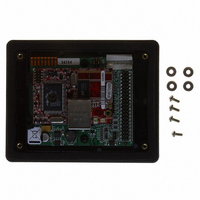101-0492 Rabbit Semiconductor, 101-0492 Datasheet - Page 23

101-0492
Manufacturer Part Number
101-0492
Description
INTERFACE OP6800 W/ETHERNET PORT
Manufacturer
Rabbit Semiconductor
Datasheet
1.101-0492.pdf
(110 pages)
Specifications of 101-0492
Module/board Type
Single Board Computer Module
For Use With/related Products
SR9160
Lead Free Status / RoHS Status
Contains lead / RoHS non-compliant
Other names
316-1060
- Current page: 23 of 110
- Download datasheet (3Mb)
3.3 Serial Communication
The OP6800 has two RS-232 serial ports, which can be configured as one RS-232 serial
channel (with RTS/CTS) or as two RS-232 (3-wire) channels using the
function call. Table 3 summarizes the options.
The OP6800 also has one RS-485 serial channel and one CMOS serial channel. The
CMOS serial channel serves as the programming port.
All four serial ports operate in an asynchronous mode. An asynchronous port can handle 7
or 8 data bits. A 9th bit address scheme, where an additional bit is sent to mark the first byte
of a message, is also supported. Serial Port A, the CMOS programming port, can be oper-
ated alternately in the clocked serial mode. In this mode, a clock line synchronously clocks
the data in or out. Either of the two communicating devices can supply the clock. The
OP6800 boards typically use all four ports in the asynchronous serial mode. Serial Ports B
and C are used for RS-232 communication, and Serial Port D is used for RS-485 commu-
nication. The OP6800 uses an 11.0592 MHz crystal, which is doubled to 22.1184 MHz. At
this frequency, the OP6800 supports standard asynchronous baud rates up to a maximum
of 230,400 bps.
3.3.1 RS-232
The OP6800 RS-232 serial communication is supported by an RS-232 transceiver. This
transceiver provides the voltage output, slew rate, and input voltage immunity required to
meet the RS-232 serial communication protocol. Basically, the chip translates the Rabbit
2000’s CMOS/TTL signals to RS-232 signal levels. Note that the polarity is reversed by
an RS-232 circuit so that a +5 V input becomes approximately -10 V and 0 V is output as
+10 V. The RS-232 transceiver also provides the proper line loading for reliable commu-
nication.
RS-232 can be used effectively at the OP6800’s maximum baud rate for distances of up to
15 m.
3.3.2 RS-485
The OP6800 has one RS-485 serial channel, which is connected to the Rabbit 2000 Serial
Port D through an RS-485 transceiver. The half-duplex communication uses the Rabbit
2000’s PB6 pin to control the transmit enable on the communication line.
The OP6800 can be used in an RS-485 multidrop network. Connect the 485+ to 485+ and
485– to 485– using single twisted-pair wires (nonstranded, tinned) as shown in Figure 11.
Note that a common ground is recommended.
User’s Manual
Mode
0
1
RS-232, 3-wire
RS-232, 5-wire
Table 3. Serial Communication Configurations
B
RS-232, 3-wire
CTS/RTS
Serial Port
C
RS-485
RS-485
serMode
D
software
19
Related parts for 101-0492
Image
Part Number
Description
Manufacturer
Datasheet
Request
R

Part Number:
Description:
COMPUTER SNGLBD BL2101 A/D 0-10V
Manufacturer:
Rabbit Semiconductor

Part Number:
Description:
CARD D/A 0-10V SR9400 SMARTSTAR
Manufacturer:
Rabbit Semiconductor
Datasheet:

Part Number:
Description:
CARD A/D 0-10V SR9300 SMARTSTAR
Manufacturer:
Rabbit Semiconductor
Datasheet:

Part Number:
Description:
WiFi / 802.11 Modules & Development Tools WIRELESS CONTROL APP KIT
Manufacturer:
Rabbit Semiconductor

Part Number:
Description:
MODULE RABBITCORE RCM3720
Manufacturer:
Rabbit Semiconductor
Datasheet:

Part Number:
Description:
MODULE RABBITCORE RCM3220
Manufacturer:
Rabbit Semiconductor
Datasheet:

Part Number:
Description:
MODULE RABBITCORE RCM3210
Manufacturer:
Rabbit Semiconductor
Datasheet:

Part Number:
Description:
COMPUTER SGL-BOARD OP6600 W/SRAM
Manufacturer:
Rabbit Semiconductor
Datasheet:

Part Number:
Description:
COMPUTER SGL-BD BL2000 SRAM/FLSH
Manufacturer:
Rabbit Semiconductor

Part Number:
Description:
COMPUTER SGL-BD BL2010 SRAM/FLSH
Manufacturer:
Rabbit Semiconductor

Part Number:
Description:
COMPUTER SGL-BD BL2000 SRAM/FLSH
Manufacturer:
Rabbit Semiconductor

Part Number:
Description:
COMPUTER SGL-BD BL2020 SRAM/FLSH
Manufacturer:
Rabbit Semiconductor

Part Number:
Description:
COMPUTER SGL-BRD BL2000 MEM/FLSH
Manufacturer:
Rabbit Semiconductor

Part Number:
Description:
COMPUTER SGL-BOARD FLASH&HEADERS
Manufacturer:
Rabbit Semiconductor










